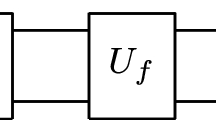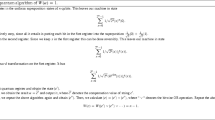Abstract
In this article we give several new results on the complexity of algorithms that learn Boolean functions from quantum queries and quantum examples.
-
Hunziker et al.[Quantum Information Processing, to appear] conjectured that for any class C of Boolean functions, the number of quantum black-box queries which are required to exactly identify an unknown function from C is \(O(\frac{\log |C|}{\sqrt{{\hat{\gamma}}^{C}}})\), where \(\hat{\gamma}^{C}\) is a combinatorial parameter of the class C. We essentially resolve this conjecture in the affirmative by giving a quantum algorithm that, for any class C, identifies any unknown function from C using \(O(\frac{\log |C| \log \log |C|}{\sqrt{{\hat{\gamma}}^{C}}})\) quantum black-box queries.
-
We consider a range of natural problems intermediate between the exact learning problem (in which the learner must obtain all bits of information about the black-box function) and the usual problem of computing a predicate (in which the learner must obtain only one bit of information about the black-box function). We give positive and negative results on when the quantum and classical query complexities of these intermediate problems are polynomially related to each other.
-
Finally, we improve the known lower bounds on the number of quantum examples (as opposed to quantum black-box queries) required for ɛ, Δ-PAC learning any concept class of Vapnik-Chervonenkis dimension d over the domain \(\{0,1\}^n\) from \(\Omega({\frac d n})\) to \(\Omega(\frac{1}{\epsilon}\log \frac{1}{\delta}+d+\frac{\sqrt{d}}{\epsilon})\). This new lower bound comes closer to matching known upper bounds for classical PAC learning.
Similar content being viewed by others
References
Bennett C., Bernstein E., Brassard G., Vazirani U. (1997). SIAM J. Comput 26(5m):1510
Grover L.K. (1996). Proceedings of the 28th ACM Symposium on Theory of Computing., pp. 212–219
Deutsch D., Josza R. (1992). Proc. Royal Soc. London A 439:553
Simon D.R. (1997). SIAM J. Comput 26(5):1474
Servedio R.A., Gortler S.J. (2004). SIAM J. Comput 33(5):1067
Angluin D. (1988). Machine Learning 2:319
Hunziker M., Meyer D.A., J. Park, J. Pommersheim, and M. Rothstein, arXiv: quant-ph/0309059 to appear in Quantum Information Processing
Ambainis A., Iwama K., Kawachi A., Masuda H., Putra R.H., Yamashita S. (2004). Proceedings of STACS pp. 93–104
Bshouty N.H., Jackson J.C. (1999). SIAM J. Comput 28(3):1136
Valiant L.G. (1984). Comm. ACM 27:1134
Ehrenfeucht A., Haussler D., Kearns M., Valiant L. (1989). Informat Comput 82:247
Blumer A., Ehrenfeucht A., Haussler D., Warmuth M. (1989). J. Assoc. Comput. Mach 36(4):929
Bshouty N., Cleve R., Gavaldà R., Kannan S., Tamon C. (1996). J. Comput. Syst. Sci 52(3):421
R. Gavaldà. Proc. Ninth Structure in Complexity Theory Conference., 324 (1994)
Heged˝s T. (1995). Proc. Eighth Conf. on Computational Learning Theory pp. 108–117
Hellerstein L., Pillaipakkamnatt K., Raghavan V., Wilkins D. (1996). J. ACM 43(5):840–862
Beals R., Buhrman H., Cleve R., Mosca M., de Wolf R. Proceedings of the 39th IEEE Symposium on Foundation of Computer Science., pp. 352–361 (1998)
Farhi E., Goldstone J., Gutmann S., Sipser M. (1998). Phys. Rev. Lett 81:5442
Boyer M., Brassard G., Høyer P., Tapp A. (1998). Fortschritte der Physik 46(4–5):493
Iwama K., Kawachi A., Raymond R., Yamashita S. arXiv:quant-ph/0411204 (2005)
Bernstein E., Vazirani U. (1997). SIAM J. Comput 26(5):1411
van Dam W. Proceedings of the 39th IEEE Symposium on Foundation of Computer Science., pp. 362–367 (1998)
Kearns M., Vazirani U. An Introduction to Computational Learning Theory. MIT Press, 1994
Shi Y. (2000). Informat. Processing Lett 75:79
Author information
Authors and Affiliations
Corresponding author
Additional information
Pacs: 03.67.Lx, 89.80.+h, 02.70.-c
Rights and permissions
About this article
Cite this article
Atici, A., Servedio, R.A. Improved Bounds on Quantum Learning Algorithms. Quantum Inf Process 4, 355–386 (2005). https://doi.org/10.1007/s11128-005-0001-2
Received:
Accepted:
Published:
Issue Date:
DOI: https://doi.org/10.1007/s11128-005-0001-2




